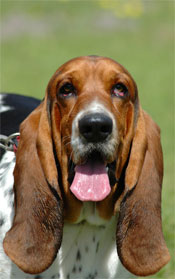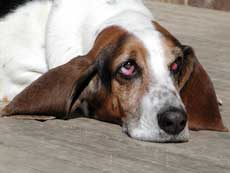|

Proportions: Basset Hounds stand roughly 33 to 38 cm (13 to 15 inches) in height at the withers. They usually weigh between 20 and 30 kg (45 and 65 lb). They have smooth, short-haired coats. Although any hound color is considered acceptable by breed standards, Bassets are generally tricolor (black, tan, and white), open red and  white (red spots on white fur), closed red and white (a solid red color with white feet and tails), and lemon and white. Some Bassets are also classified as gray, or blue, however this color is considered rare and undesirable. white (red spots on white fur), closed red and white (a solid red color with white feet and tails), and lemon and white. Some Bassets are also classified as gray, or blue, however this color is considered rare and undesirable.
Features: They have long, low-set ears and powerful necks, with much loose skin around their heads that forms wrinkles. Their tails are long and tapering and stand upright with a curve. The tail should also be tipped in white. This is so they are easily seen when hunting/tracking through large brush or weeds. The breed is also known for its hanging skin structure, which causes the face to have a permanently sad look; this, for many people, adds to the breed's charm. The dewlap, seen as the loose, elastic skin around the neck and the trailing ears help trap the scent of what they are tracking.
The Long and Short of It: Basset Hounds are a large dog on short legs. They were originally bred by the French to have achondroplasia, known as dwarfism. Their short stature can be deceiving: Bassets are surprisingly long and can reach things on table tops that dogs of similar heights cannot.

 Personality: The Basset Hound is a very calm and companionable breed, but they are often very stubborn. They are an especially loyal breed known for their pleasant disposition and emotions that sometimes seem almost human. Around strangers, Bassets are friendly and welcome the opportunity to make new friends. For this reason they are an excellent pet for families with children Personality: The Basset Hound is a very calm and companionable breed, but they are often very stubborn. They are an especially loyal breed known for their pleasant disposition and emotions that sometimes seem almost human. Around strangers, Bassets are friendly and welcome the opportunity to make new friends. For this reason they are an excellent pet for families with children
Physical Needs: While Bassets love food and may be less energetic than some breeds, they will exercise regularly if given the chance. Most Bassets enjoy activities that use their natural endurance, like long walks or hikes. They also enjoy tracking games that let them use their powerful nose. Owners who believe their Bassets are supposed to be lazy will likely end up with overweight dogs that get exhausted easily, and owners who keep their Bassets active will likely keep their basset trim and healthy.
Training: Like other hounds, Basset Hounds are often very difficult to obedience train. Many Basset Hounds will obey commands when offered a food reward, but will "forget" the training when a reward is not present.
Bassets are notoriously difficult to housebreak. Training and housebreaking are not impossible, however, and can be accomplished with consistency and patience on the part of the owner.
Tracking the Scent: The breed has a strong hunting instinct and will give chase or follow a scent if given the opportunity. They should be trained in recall; failing that, they should be kept on a leash when out on walks.
Expressive Dogs: Bassets might howl or bay rather than bark when they want something or to suggest that they think something is wrong. They also use a low, murmuring whine to get attention, which sounds to many owners as though their Bassets are "talking."
Basset Health:In comparison to other breeds, the Basset Hound is an especially healthy breed, but there are some illnesses to which they may fall prey.
They are a deep-chested breed, and are therefore prone to bloat. Many bloodlines are genetically prone to glaucoma, luxating patella, and ectropion ("cherry eye"). Young Bassets occasionally develop panosteitis. Older Bassets occasionally develop Von Willebrand disease. Long dogs on short legs can easily develop back pain, especially if excessive weight is already a concern. Hip dysplasia can be a problem in Bassets.  Due to the breed's short legs and large mass, Bassets may be susceptible to arthritis as they grow older. Gray Basset Hounds are more likely to be born with medical problems, and it is advisable not to purchase these. Due to the breed's short legs and large mass, Bassets may be susceptible to arthritis as they grow older. Gray Basset Hounds are more likely to be born with medical problems, and it is advisable not to purchase these.
Also, the life expectancy for an
average Basset usually lies between
8 and 12 years of age, but there are
extreme cases where they live beyond
14 years old.
Care: Bassets tend to shed a lot, but do not require frequent brushing. Like the Bloodhound, they are a "wet mouthed" dog and tend to drool. As Basset Hounds often overeat, feedings should be regulated to prevent weight gain. Long ears are prone to infection if not cleaned regularly. The pronounced haw of the eyes can become dry and irritated. Trailing bellies and massive paws will carry and track dirt to the despair of many owners. Untrimmed toenails can cause damage to floors and furniture, and create posture difficulty leading to back pain.
Training: Gentle and patient training is the most effective form of training. Trainers must be persistent with the breed in order to achieve a well mannered dog. The Basset has the tendency to become stubborn by listening to their nose, rather than their master. Owners need to make the training process lively and entertaining to allow the Basset to learn more efficiently.

 Basset History: Basset Hounds are an aristocratic breed of French lineage, and descendants of the St. Hubert's Hounds. Friars of St. Hubert's Abbey in medieval France desired a shorter-legged dog, capable of following a scent under brush in thick forests, as hunting was a classic sport of the time. Both Bassets and St. Hubert's Hounds were bred to trail, not kill, their game. Bassets were originally used to hunt rabbits and hare. The first application of the word "Basset" to a breed of dog can be traced to an illustrated text on hunting written by Fouilloux in 1585. Basset History: Basset Hounds are an aristocratic breed of French lineage, and descendants of the St. Hubert's Hounds. Friars of St. Hubert's Abbey in medieval France desired a shorter-legged dog, capable of following a scent under brush in thick forests, as hunting was a classic sport of the time. Both Bassets and St. Hubert's Hounds were bred to trail, not kill, their game. Bassets were originally used to hunt rabbits and hare. The first application of the word "Basset" to a breed of dog can be traced to an illustrated text on hunting written by Fouilloux in 1585.
Early French Bassets closely resembled the Basset Artésien Normand, which is still extant today though it is not recognized outside of France. Because many short-legged dogs from this time were called basset and record-keeping from this time was sparse, it is difficult to know which of these breeds have bloodlines in common with today's Basset Hounds. It is commonly believed that Marquis de Lafayette brought Basset Hounds to the United States as a gift to George Washington.
In 1863 the Basset Hound reached international fame at the Paris Dog Show. At that time there were two common Bassets, those with a rough coat (Basset Griffon) and those with smooth (Basset Français). The dogs were further classified by the length of their legs. The two popular Basset breeders at this time were M. Lane and the Count Le Couteulx.
In 1866, Lord Galway imported a pair of Le Couteulx Bassets to England, but
it was not until 1874 that Basset Hounds were widely introduced there by Sir Everett Millais. The Kennel Club accepted the breed in 1882 and the English Basset Hound Club was
formed in 1884. The American Kennel Club first recognized Basset Hounds as
a breed in 1885. In 1935, the Basset Hound Club of America was organized in the United States. The current American breed standard was adopted in 1964.
Popular Culture:
Basset hounds have become a staple in American popular culture. In 1928, Time magazine featured a Basset Hound on the front cover. The accompanying story was about the 52nd annual Westminster Kennel Club Dog Show at Madison Square Garden as if observed by the Basset Hound puppy. This prestige is often seen as the event which made the Basset Hound a popular part of American pop culture.

Cartoon Characters:
* The cartoon character Droopy Dog, originally created in 1943 by Tex Avery.
* Fred Basset, the main character in the comic strip Fred Basset, created by Alex Graham in 1963.
* Rosebud the Basselope from Berke Breathed's comic strip Bloom County.
* Lafayette, from the 1970 Disney film The Aristocats.
Films and TV:
* Cleo, in Jackie Cooper's 1950s TV show The People's Choice.
* The Basset Hound named simply "Dog" from 1970s TV series Columbo.
* Fred, the companion of Cledus in the 1977 movie Smokey and the Bandit.
* Flash, the dog owned by Sheriff Rosco P. Coltrane in the 1980s TV series The Dukes of Hazard. A life-sized replica named "Flush" was used in dangerous situations.
* Quincey, owned by Luther in the 1990s sitcom Coach.
* Sammy from the TV series That's So Raven.
* Some Bassets in Hats in Nanny McPhee.
* Socrates, the companion of Maxine Gray in the 1999-2001 seasons of the drama Judging Amy.
* Gabriel, Batou's basset hound in Ghost in the Shell 2: Innocence. Gabriel is in fact director Mamoru Oshii's real life pet, and is included in many of his films.
* Elvis Presley sang "You ain't nothing but a hound dog" to Sherlock, a basset hound, on the Steve Allen Show, July 1, 1956.
In advertising
* The logo for Hush Puppies brand shoes; Basset Hounds are occasionally referred to as "Hush Puppies" for that reason. The dog used in the photos was named "Jason".
* A Basset Hound is the companion to the lonely Maytag Man in Maytag appliance advertisements
All text is available under the terms
of the GNU Free Documentation License
|
